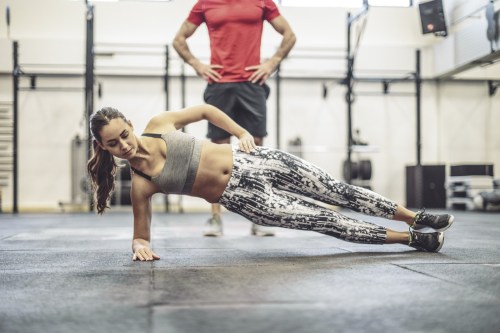Give me a series of arm, ab, or ass sculpting moves, and nine times out of ten I’ll be able to (very sweatily) power my way through them. But the minute a trainer mentions that it’s time to target obliques, I am out.
IMHO, there is no muscle group more difficult to sculpt—less than 15 seconds into a side plank, and my entire body is quaking. So if I am going to suffer through the motions of strengthening my obliques, I want to make sure I’m doing it as quickly and efficiently as possible in order to keep the time I have to spend on the moves as minimal as possible. To find out how to get the most bang for my oblique-work buck, I consulted SLT trainer Ian Richardson, who regularly puts my side body through the absolute ringer in his Megaformer classes.
“Proper form is essential when it comes to any exercise being effective,” he explains. “Proper form, whether you modify or advance the exercise, will allow the muscle to become stronger, thus reaping the benefit of the exercise itself. When it comes to working your oblique, be cognizant of how your feet are placed, the alignment of the hips in relation to the rest of your body, and the placement and alignment of the elbow and shoulder.”
As straight-up awful as oblique exercises can be, Richardson notes that they really are important—and not just for the sake of having those J.Lo inspired V-lines on your abs. Side planks, for example, help strengthen the quadratus lumborum muscle, which can help alleviate back pain. Plus, your obliques are a part of your core, which happens to be, ya know, at the core of your entire muscular system.
And though it might seem like it, oblique work doesn’t have to be as snooze-inducing as simply hanging out in alternating side planks. “Spice it up! There are so many different variations out there that can be added to your oblique work that will make the work more stimulating,” says Richardson, calling out side plank crunches, threading the needles, and lateral pulls as some spicier options. “Experiment with using an unstable surface to challenge your center core, like a gym ball or a Bosu ball [or the carriage of the Megaformer at SLT]. You can place either the forearm or you feet or knees on the unstable surface, which will surely help to fully fatigue your oblique.”
Or, you can try this series, which left my entire mid-line on fire when Richardson put me through it this a.m.:
1. Start in a side plank with your left forearm directly under your left shoulder, feet stacked directly on top of each other.2. Engage your core and lift your hips until your body is in a straight line.3. Pulse your hips up and down for 15 seconds, holding core tight.4. Transition through the center, hitting a forearm plank with both forearms parallel and the balls of your feet side-by-side, hips lifted, and core engaged.5. Rotate to right side plank, maintaining form.6. Pulse your hips up and down for 15 seconds, holding core tight.7. Repeat for three times total on each side.
A pro tip from Richardson: “The key is to keep your core engaged the whole time and to not let your hips drop or dip down,” he explains. “The transition through center into your forearm plank adds an element of balance and agility that is tied to the center core muscles remaining active and engaged. Each variation is 15 seconds in length, the shorter intervals keeping you moving, thus spiking your heart rate during the workout.”
For more another ab workout that will get you quaking, try this 8-minute at-home core workout care of Charlee Atkins. Plus, this is why your workout sometimes brings you to tears.
Sign Up for Our Daily Newsletter
Get all the latest in wellness, trends, food, fitness, beauty, and more delivered right to your inbox.
Got it, you've been added to our email list.











